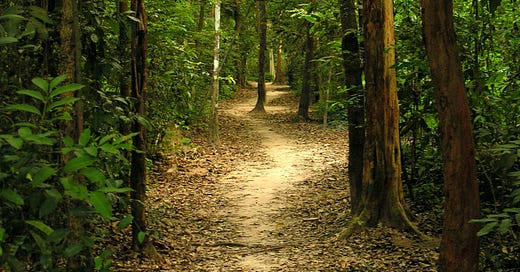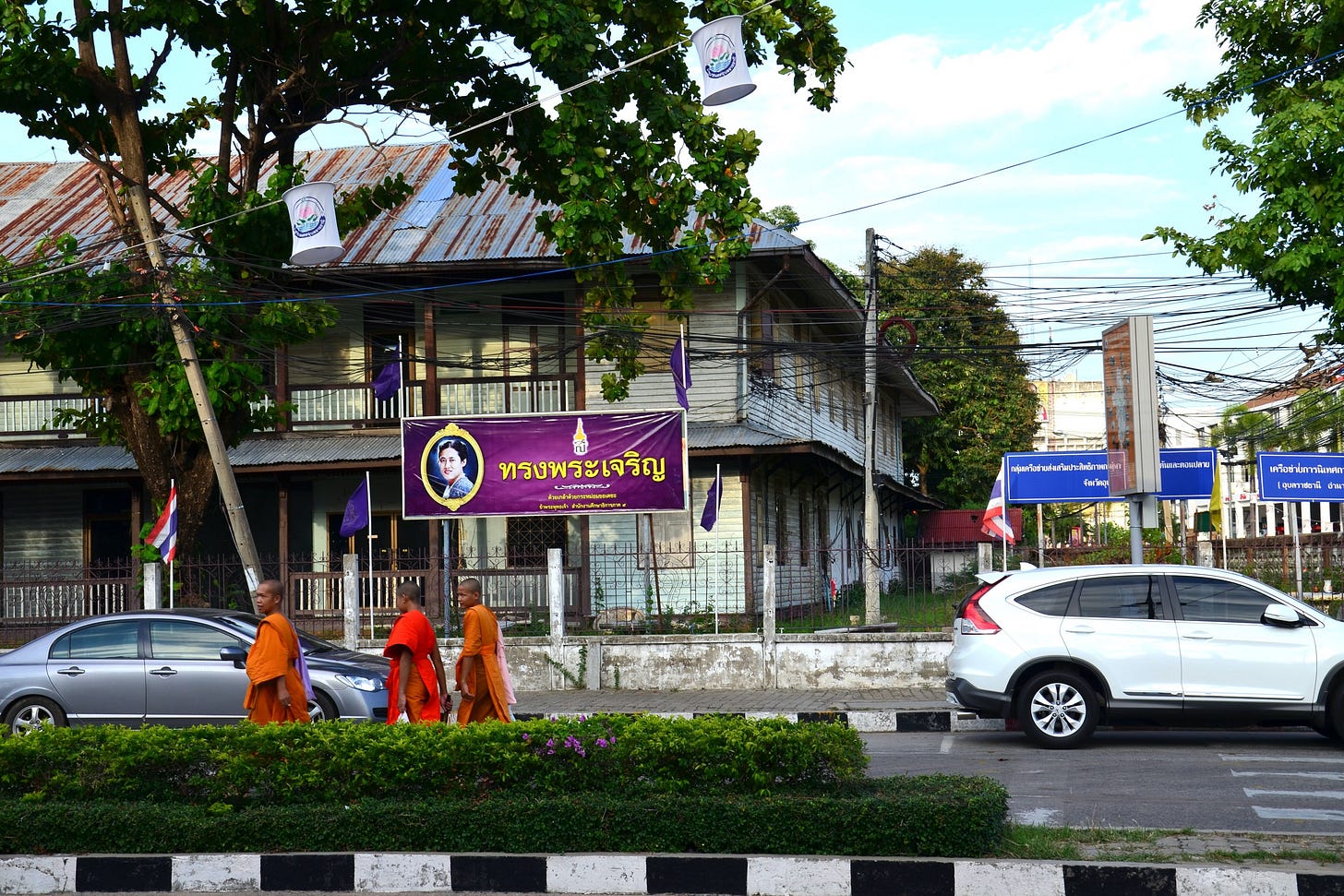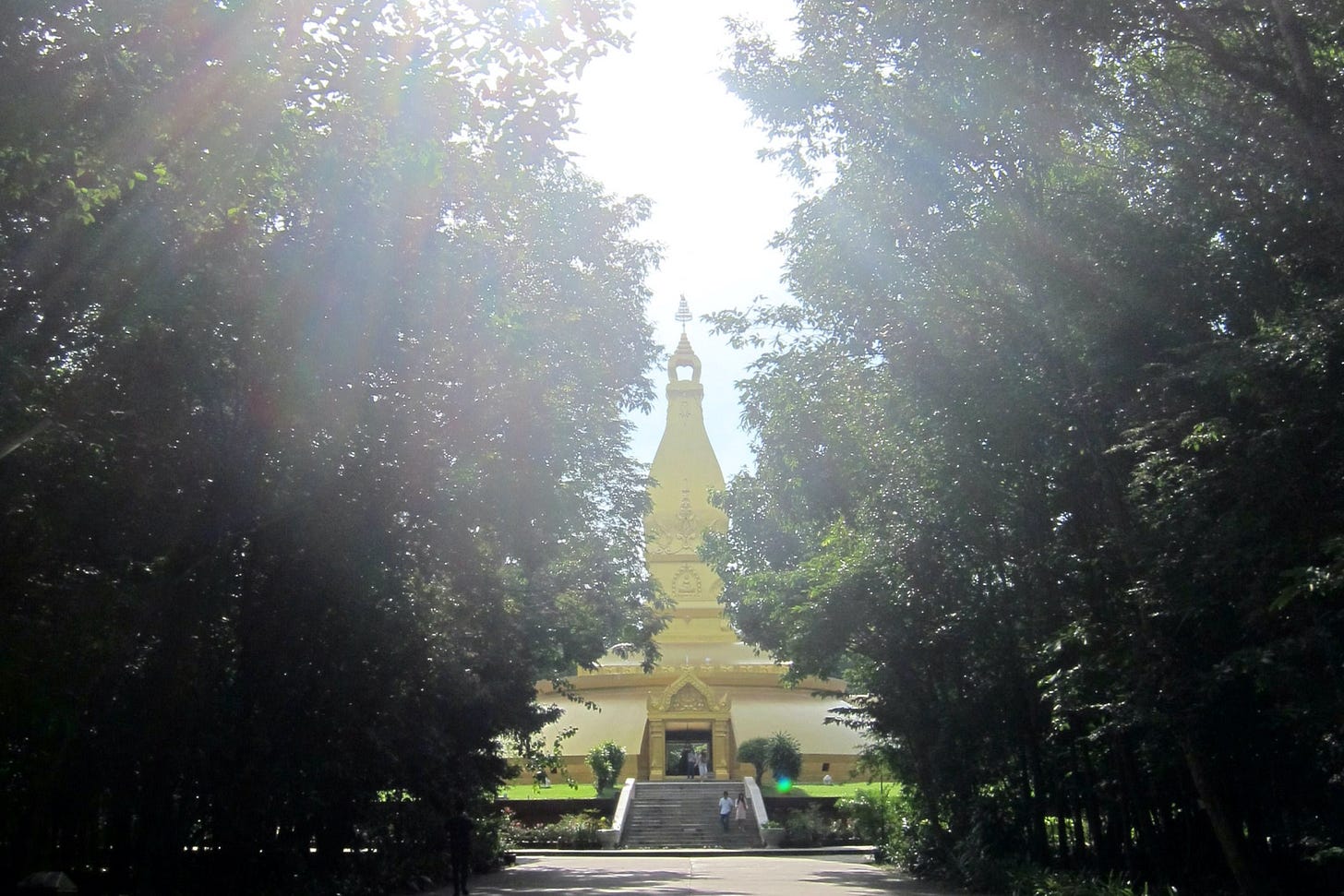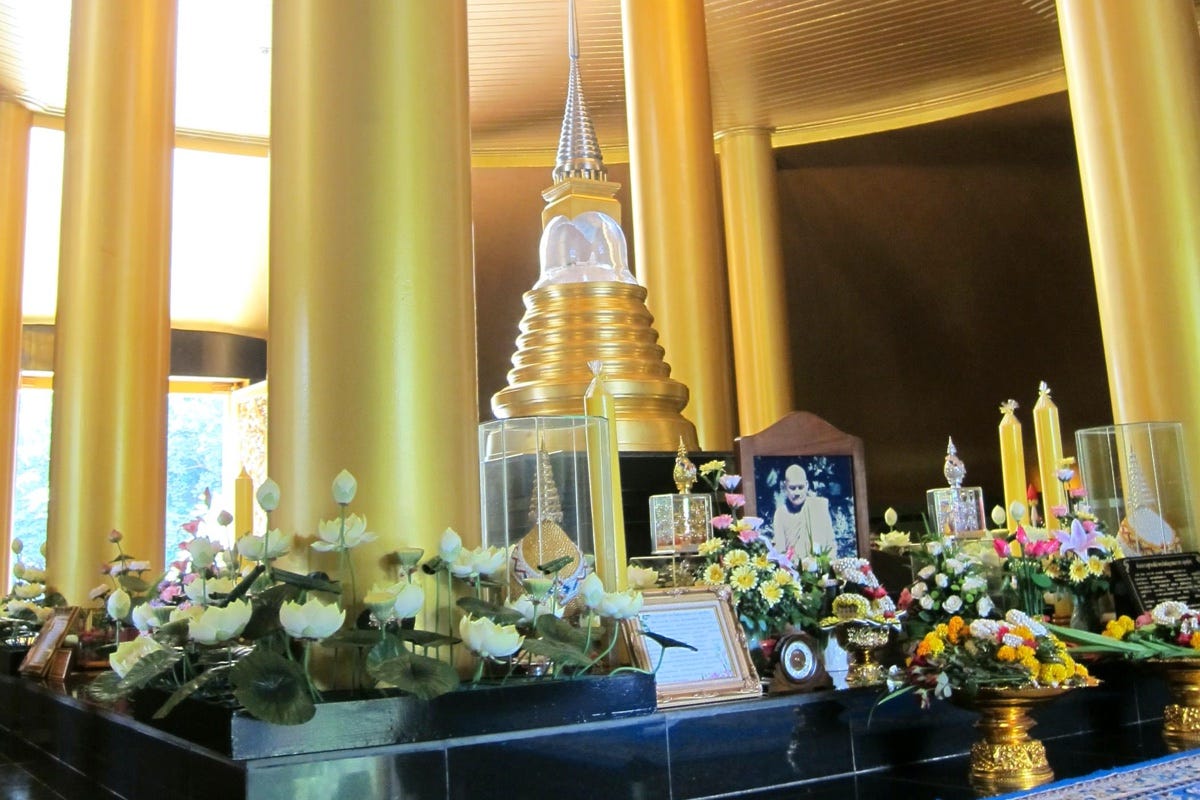As this is the 200th Couchfish itinerary post, I’m making it a free for all to read. Today is on the topic of a forest temple that touched my heart and I touched the earth—or something like that anyway! Thank you all for following the Couchfish itinerary day by day—200 down, 200+ to go. Thank you so much.
If you’d like to subscribe for the full version of Couchfish, it costs US$7 per month and you get access to the full archives. Cheers!
If you’re anything like me, you may have kicked off your overseas travels with a bit of a jaunt through Europe. At every new village, town or city my guidebook (Lets Go, sorry), would stagger towards churches (if anything). Stagger seems the right word going off the ex–Lets Go authors I know. I’m not religious, and there are only so many churches I can take, before I think “God, anything but another church”. Thailand is much the same. Meet “wat fatigue”.
Godliness of Goldliness. Within Wat Nong Bua, Ubon Ratchathani. Photo: David Luekens.
Before you start calling me a heathen, I know Thailand has some magnificent temples. Try a pre–dawn breakfast within Wat Pho (permission required), before Bangkok wakes up—memorable to say the least. For me though, by and large, the appeal is mostly in the buildings, the setting, the history, more-so than the divine.
According to the Asean Studies Centre (Thanks Pook!) there are over 40,000 Buddhist temples in Thailand. Roughly one temple for every 1,750 people. I have no idea what the figure is for churches in Europe, but as a 20–something not interested in churches, I’m sure I saw 40,000. Ok, I’m exaggerating, I’m sure I visited at least four—what are a few zeroes?
Hand–painted cinema posters, Ubon Ratchathani. Photo: Stuart McDonald.
Where am I going with this? I’m going to Ubon Ratchathani (Ubon to its friends) in Northeast Thailand. It is, without a doubt, my favourite temple town in the country. It is also the hub of the best eating in the region. It might not rock a tourism board’s boat but in my opinion, godliness and stuffing face make good companions.
Ubon’s temple scene is a glad-bag of attractions. There’s bling. There’s an Indian temple knockoff. There’s crocodile guardians and lions with slicked back hairstyles. You can carve wax. In one, you can crouch down, rest your fingers on a stone marker on the floor, and have a vision of your life played out. Spoiler—it didn’t work for me—probably too much BBQ chicken oil on my fingertips. Damn it, always go for a revelation, then the barbecued chicken. The TAT loves this stuff, but my advice is to cast your net further.
Leave outside behind you. Photo: David Luekens.
I suggest you capture two forest wats with your net. They’re flung a little outside of town, but easily visited by tuk tuk or scooter. At these, I didn’t want to touch the earth for a cliched revelation—I wanted to touch the earth because I needed to. They’re those kind of places.
Ubon sits towards the southeast extreme of the Khorat Plateau. The terminus of the southern Northeastern train line. It lies within spitting distance (if you can spit that far) of the Lao and Cambodian frontier. Below it sits the “Emerald Triangle” a doomed tourism concept probably birthed in a TAT conference room. More on our trip to explore that another day...maybe.
All you need to keep the outside world out is a bamboo fence. Photo: Chin Chongtong.
I mention the plateau, because save the cliffs by Khong Chiam, the province is largely dead flat. Riding towards the first of the two temples, early morning, with big skies, something jutted out.
Trees.
People don’t call them forest wats for nothing. It is like a stand of forest dropped from the heavens. The epicentre of Thailand’s “forest tradition”. Fenced in, the woods seems doubly tall because all around them, as far as the eye can see, is knee–high rice stubble. No people—just blue steel carving up an ochre canvas.
Follow this guys. Photo: David Luekens.
We park the bike and walk in. The road outside is far from busy. An errant truck and young guy with an idiot exhaust pass by, but the outside world melts away as we walk in. Fast.
Thanks to our timing, there’s no chanting or activity. There’s a few birds above, but this isn’t a rainforest—it isn’t teaming with wildlife—this is dry northeastern woods. It just ... feels removed from everything. Everything.
We wander. There is an obvious way, but we take smaller footpaths—sometimes dirt sometimes paved. Above us, trees soar. We’ve not seen a soul since we parked the bike. There’s a morning breeze, not much though being dry season and all. Tree tops smooch and caress more than dance. It feels like we need to ask permission to breathe.
Can you see the light? Photo: Stuart McDonald.
How many places have you been where you felt you needed to silence your breath? Your thoughts? How does one breathe quietly? Walk quietly? Exist quietly?
Clear the mind. One step at a time. Follow the path.
I’ve tried meditation a few times, but it has never worked for me. My mind is too full of garbage and noise. At that forest temple though, thinking about it now as I write this, I couldn’t think about a better place. A better place for what? To calm a noisy mind of course.
We keep walking, wandering, still not a soul. There’s no squirrels or monitors, or anything else. We reach a few kutis—small simple wooden housing for monks—easy to build on Mindcraft, not so easy to live in. There’s saffron robes hanging on veranda railings—to dry I assume—but still, not a monk in sight. It feels abandoned, but it also feels like ours.
Must not think about Somtum Jinda. Photo: David Luekens.
I want to sit. Not because I’m tired, rather because I’ve never been anywhere like this before.
I don’t remember how long we spent walking. Thinking back, it feels likes hours. At one point, lost in the grounds, sitting on a log for a breather, a youngish monk, not a novice, walks past. He doesn’t ignore us—no, he’s not being rude—he simply seems not to see us—no, he wasn’t floating!
And that, more than anything, feels like the magic of the place.
Out of the woods. Photo: Stuart McDonald.
Touch the earth, take a breath, squat down and push all ten fingers into the soil. Listen to the silence. Close your eyes. The trees sway, even in the stillest of days—listen carefully and you’ll hear. Look inwards. Close your eyes. Feel the planet roll.
Not all temples are equal.
Tomorrow, I’ll be jolting you out of this meditative revelry with some serious eating. Pack an empty stomach.





















Share this post